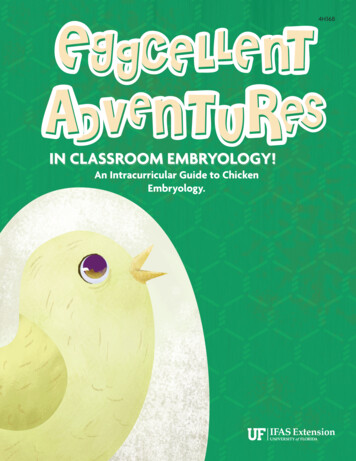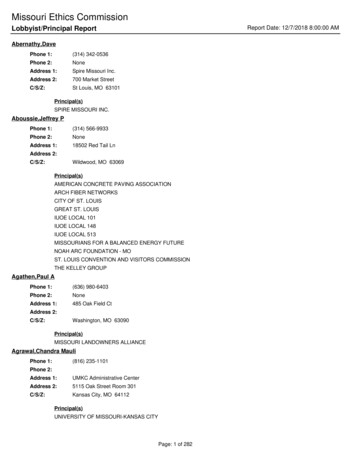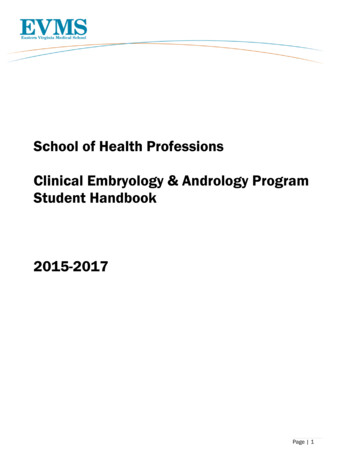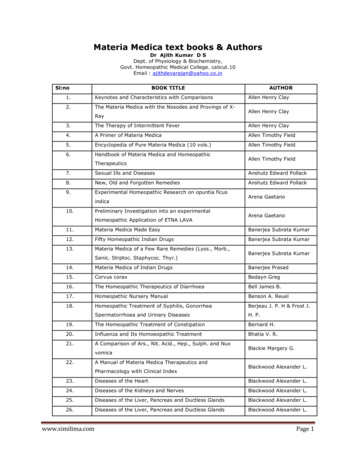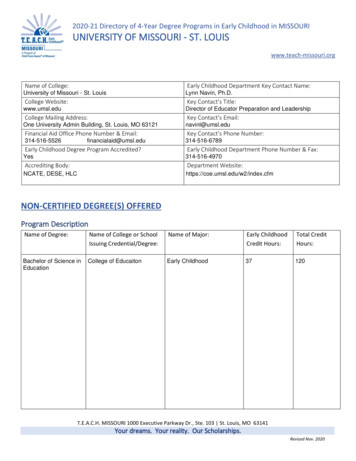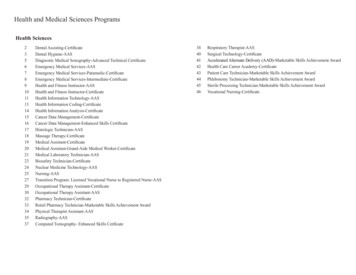
Transcription
BOLK’S COMPANIONSFOR‑THE STUDY OF MEDICINEEMBRYOLOGYEarly developmentfrom a phenomenologicalpoint of viewGuus van der Bie MD We wouldbe interestedto hear youropinion about this publication.You can let usknow at http://www.kingfishergroup.nl/questionnaire/
About the Louis Bolk InstituteThe Louis Bolk Institute has conducted scientificresearch to further the development of organic andsustainable agriculture, nutrition, and health care since1976. Its basic tenet is that nature is the source ofknowledge about life. The Institute plays a pioneeringrole in its field through national and internationalcollaboration by using experiential knowledge and byconsidering data as part of a greater whole. Throughits groundbreaking research, the Institute seeks tocontribute to a healthy future for people, animals, andthe environment. For the Companions the Instituteworks together with the Kingfisher Foundation.Publication number: GVO 01ISBN 90-74021-29-8Price 10 (excl. postage)KvK 41197208Triodos Bank 212185764IBAN: NL77 TRIO 0212185764BIC code/Swift code: TRIONL 2UFor credit card payment visit our website atwww.louisbolk.nl/companionsFor further information:Louis Bolk InstituteHoofdstraat 24NL 3972 LA Driebergen, NetherlandsTel: ( 31) (0) 343 - 523860Fax: ( 31) (0) 343 - euColofon: Guus van der Bie MD, 2001, reprint 2011Translation: Christa van Tellingen and Sherry WildfeuerDesign: Fingerprint.nlCover painting: Leonardo da Vinci
BOLK’S COMPANIONSGuus van der Bie MDFOR THE STUDY OF MEDICINEEmbryologyEarly Development from aPhenomenological Point of view
About the authorGuus van der Bie MD (1945) worked from 1967 to1976 as a lecturer at the Department of MedicalAnatomy and Embryology at Utrecht StateUniversity in the Netherlands. As a family physiciansince 1976, he has recognized the importanceof phenomenology and Goethean science forunderstanding the human being in health andillness. Next to his practice he stayed involvedin teaching medical students at Utrecht StateUniversity and physicians, and therapists. In 1998he was one of the originators of Renewal of MedicalEducation, a project of the Louis Bolk Instituut toproduce a complement to the current biomedicalscientific approach of the human being.Since 2002 he is a teacher of ComplementaryMedicine and Medical Humanities at the MedicalSchool of Utrecht State University and teachesanthroposophic medicine at the University ofWitten/Herdecke (Germany). He is a member of theMedical Section of the School of Spiritual Science atthe Goetheanum, Dornach, Switzerland.Bolk’s CompanionsEmbryology - 3About the projectThe project Renewal of Medical Education aimsto produce Companions that demonstratehow the insights of current biomedical sciencecan be broadened by using the Goetheanphenomenological method. This method innovatescurrent concepts and expands the understandingof biochemical, physiological, psychological, andmorphological factors in living organisms and theirdevelopment in time and space, and in health,illness, and therapy. The project is commissionedby the Kingfisher Foundation, which aspires thedevelopment, application, and publication of theGoethean phenomenological research method inthe widest sense, to complement and innovate theaccepted scientific view and research method.BOLK’S COMPANIONS FOR THE STUDY OFMEDICINE complement current medical education,specifically disclosing human qualities in thefundamental biomedical sciences of today.BOLK’S COMPANIONS FOR THE PRACTICEOF MEDICINE contribute to a scientificphenomenological basis for integrative medicineand integral psychiatry.
ContentsPreface6Acknowledgements71. Introduction82. enesisFertilizationSummary and conclusion3. First week of onCell membrane continuityZona pellucidaCell cleavageCompactionEmbryopauseFrom fertilization to implantation: a special period of time?The development of twinsSummary and conclusionMorphologyGoethean aspects4. Second week of minar germ discSummary and conclusionsMorphologyGoethean 42626272727
5. The third week of .2.2.MorphologyDevelopment of axial symmetry in the germ discPrimitive streak and mesodermThe cylindrical body form, the folding processesDifferentiation of the internal organsSummary and conclusionsMorphologyGoethean aspects6. Embryonic periodMorphologyFolding processProcess of unfoldingSummary and conclusionsMorphological considerationsGoetheanistic aspects7. Characterizing four processes of developmentintroductionThe physical state of individual developmentPhysical substance in biologySurface and boundaryPhysiological processes of individualized life and metamorphosisA structure in timeMetamorphosisLife processes and consciousnessConsciousness, physiology, and reflexesPsycho-neuro-pharmacologyA relation between the inner and outer worldConsciousness, behavior and determinism8. Four qualities in early development: ral aspectsRelation between center and peripheryMorphodynamics in the first phaseMorphodynamics in the second phaseMorphodynamics in the third phaseMorphodynamics in the fourth phase9. Synopsis9.1.LiteraturePhases of 751515252525353555557Embryology - .2.7.4.3.7.5.2828282931323232Bolk’s Companions6.1.6.1.1.6.1.2.6.2.6.2.1.6.2.2.28
PrefaceIn his book Lifelines Steven Rose states: “The challenge to the opponents of biologicaldeterminism is that, while we may have been effective in our critique of its reductionistclaims, we have failed to offer a coherent alternative framework within which to interpretliving processes.”We have the same challenge with regard to morphology and embryology. It is imperativeto offer a satisfactory alternative framework. In trying to remedy this problem we havestriven for to reach two goals: first, to indicate an ‘alternative framework’ in morphology,and second, to show that the alternative framework which characterizes dynamic qualityin morphological phases opens new possibilities for interpreting morphological processes.We achieved the characterization of the dynamic quality in morphological phases by usinga phenomenological approach to morphology, and then interpreting this with the help ofGoethean science. We think a new framework will be helpful if it can be shown to referto functional entities in biology. In this case, many facts and details can be seen in acontext and understood as belonging to recognizable phases of development. We chosethe dynamic quality in morphological phases for this purpose since it allows us to seecoherence in the facts. The dynamic quality in morphological phases can be shown to referto functional processes in biology.This results in new concepts in morphogenesis. These new concepts recapture anunderstanding of morphogenetic factors in living organisms and their development intime and space. This gives us, for instance, a possibility of understanding the relationconsciousness and behavior to the shape of the body.We hope that this framework will be helpful for medical students, who have to learn andremember many morphological details.Experience has taught us that an overview of the whole makes remembering the detailseasier. We present this module in an effort to aid medical students and others to take inthe wonderful world of embryology and remember it better in later study and work.We want to emphasize that this module does not replace the textbook on embryology.The information in the module is compact and presupposes the knowledge contained inregular textbooks. Morphogenetics is the study of how form and shape develop
AcknowledgementsThis module in the series BOLK’S COMPANIONS FOR THE PRACTICE OF MEDICINE was written atthe Louis Bolk Instituut, Driebergen Holland. It is a result of the stimulating exchangeof ideas with my colleagues W. Schad, Chr. van Tellingen, G. Verhaagen, H. Vögler, J.van der Wal and R. Zech. I am most grateful to them for their valuable comments, and Iam glad we are not at the end of this exciting journey. The next subject to be studied isorganogenesis. I hope our cooperation in studying organogenesis will be equally fruitful.Guus van der Bie MD, Driebergen April 2001.Bolk’s CompanionsThis project was made possible financially by gifts from Iona Stichting, Stichting Phoenix,Pharma Natura (S. Africa), Stichting ter Bevordering van de Heilpedagogiek, StichtingTriodos and Kelly Sutton.Embryology - 7
1. IntroductionEarly development in human embryologyEmbryonic development can be divided into different developmental phases. Like everybiological developmental process, embryological development is a process in time and assuch the visible stages appear as a continuous process in time. Stages and phases are infact artificially produced by the observer. Therefore, the observer has to be aware of thecriteria he or she uses in differentiating the various phases.When we look at the developing plant, for instance, it can be seen to grow according to aparticular time pattern which is structured by morphological and functional changes. Weclassify its phases based on these morphological and functional changes.The term ‘phase’ is used to define and describe a time period during which a particularprocess takes place. In plant-life, for instance, we can discern germinating, growing, andflowering as clearly different processes and we use a particular term for each phase. Eachprocess (germinating, growing, and flowering) represents a particular aspect of plantdevelopment resulting in particular plant products or plant parts.However, the differentiation of phases is not just a result of observation, it also has acounterpart in the process of conceptualization in the human mind: i.e. we recognize agroup of phenomena as belonging to a particular process. The changes in the describedprocesses determine whether development is at one phase or another, and visiblephenomena belonging to certain stages can be seen as belonging to one larger develop mental phase. A phase therefore may cover different stages.Here we shall try to find the characteristic features of different phases in embryologyby using Goetheanistic phenomenology as a scientific approach: morphological andbiological phenomena in different organisms are studied and compared in order to findout what the characteristics of their relationships are, what they have in common and howthey are different.Comparing the development of various organisms makes it possible to discover what canbe taken as the same process in different organisms. This enables us to recognize generallaws and stages in morphogenesis.
This method shows us what determines visible phenomena. When we give processes aparticular name, e.g. ‘cell differentiation’, ‘organogenesis’ or ‘programmed cell death’ weshould be aware that we are using a superimposed conceptual framework. Every individualcell’s life is embedded in processes of a ‘higher’ level; it ‘obeys’ the laws specific to whatis to be developed as an expression of the superimposed process of the higher level (forinstance gastrulation).We have taken Langman’s Medical Embryology as a basic text which exemplifies medicalscience as it is taught in medical schools today. In that sense our effort should beconsidered to be an attempt to follow contemporary medical education, showing that aEmbryology - 9Note!It is important to note that Goetheanistic science finds characteristic morphologicaldifferences between minerals, plants, animals and human beings. This is due to the factthat a macroscopic point of view is chosen. In his scientific approach, Goethe was lookingfor the ‘archetypal phenomenon’. This archetypal phenomenon represents the dynamicquality of a specific morphological phase.When we look from the point of view of molecular biological, it is evident thatmorphological differences between minerals, plants, animals, and human beings disappearfor our consciousness. From a scientific point of view there is no necessity to make a choicebetween the two points of view. It should be emphasized that it lies in the freedom of thescientist which point of view is chosen. Integration of both points of view is possible withinthe realm of Goetheanism.Bolk’s CompanionsIt is also important to be aware of the way the Goetheanistic scientist approaches anobject. In analytical science, the scientist has the attitude of ‘onlooker’. In Goetheanisticscience, the scientist works with a participative attitude. He participates consciously inwhat is going on in morphological processes. This kind of consciousness enables thescientist to recognize movement and gesture working in morphological processes.In contrast to the usual scientific approach of analysis and reduction we may broaden ourview in Goetheanistic science, in the sense of taking in the ‘whole’ of the phenomenonand their context.
goetheanistic approach can complement and augment modern scientific approach andstudy.It is common nowadays to give a bio-molecular explanation of life processes in morphology.Studying molecular biology, particularly genetics, makes us aware that even genes in theircomplicated and marvelous structures and functions need an explanation in their own right.Understanding protein metabolism is quite different from understanding morphogenesis,and describing the protein metabolism that takes place during morphological developmentdoes not mean that the description is an explanation of how form and shape develop(morphogenesis).Morphogenesis is the subject of this publication. The central question that gives thisstudy its particular form is: are we able to understand individual cell differentiationand morphological development in relation to specific superimposed processes? Bydiscriminating different phases of development we are immediately confronted with thecoherence of multiple phenomena that are part of one superimposed process, for instancea process such as ‘gastrulation’ (see 5.2.2).This scientific approach has many practical implications. Molecular biology gives anexplanation of processes in substances; however, this cannot fully explain morphology orconsciousness.The specific laws of life processes and mental capacities can be recognized asdifferentiating forces in embryological development and morphology. The Goetheanisticscientific approach opens up the possibility of understanding the relation between bodilyform, life process, and mental capacity.
2. Gametogenesis2.1. Morphology2.1.1. GametogenesisWe see immediately that a pronounced polarization takes place.The process of polarization includes germ cell differentiation in opposite directions.Embryology - 11Gametogenesis starts with the primordial germ cell. From this stage on, differentiationinto the oocyte in the female organism, on the one hand, and the sperm cell in the maleorganism, on the other, is a process of increasing divergence. We can list a great number ofproperties of the primordial cells, which in subsequent differentiation develop in oppositedirections in oocytes and sperm cells.For instance when we look at:OocyteSperm cellcell volume --condensation of DNA-- mobility-- total number of produced cells400Numerous localization in the abdomenInsideOutsidetemperature needed for differentiationWarmCoolBolk’s CompanionsGametogenesis provides a good example of a dynamic quality in morphogenesis asa superimposed process, as described in the preface. In gametogenesis the process ofpolarization is the working principle ‘behind the actual facts’. In studying this process, youcan clearly experience the difference between observing visible facts and stages, and themental process of thinking about those observations. The concept of polarization remainsinvisible for the physical eye, but it becomes nonetheless ‘visible’ with the help of ourthought process.
However, there is at the same time a reciprocal development in germ cell differentiation.We can see this by looking at the relevant cell properties mentioned above: cell structuresthat become more important, dominant, or clearly expressed in one cell (oocyte) becomeless important in the other cell (sperm cell), and vice versa. While developing in completelyopposite directions, there is a strong inner relationship between the two processes, whichis expressed by the reciprocal characteristic of the process. The inner relationship withinthis development can help us understand the process of polarization and the reciprocalattraction between oocyte and sperm cell. All phenomena and characteristics of thepolarization of the two gametes can be summarized as follows: the oocyte tends tospecialize and unidirectionally differentiate to express the features and qualities of thecytoplasm of the normal cell. The spermatocyte, on the other hand, exhibits the qualitiesand ‘behavior’ of the nucleus of the cell.2.1.2. FertilizationFertilization is a necessary condition for the development of a new human being.The main process that creates the conditions of fertilization is polarization. It will becomeclear that any polarization can be understood as creating conditions and possibilitiesfor new development. We will learn to understand that processes such as the polardifferentiation of embryoblast and trophoblast, epiblast and hypoblast, ectodermand endoderm in later phases of embryonic development, create new possibilities indevelopment. Thus gametogenesis can be considered as a basic exemplary phenomenonwhich points to the creation of new possibility: the development of the zygote.Fertilization takes place the moment both gametes are at the end of their life anddevelopment. At fertilization both oocyte and sperm cell each can live only one or twomore days and then will die if fertilization does not take place. Therefore they can beconsidered to be cells on the ‘edge of life and death’. The only function they have left is togive away their complete physical substance in fertilization.This phenomenon again is very instructive. It shows that specialization and the possibility todevelop in many directions (multipotentiality) are opposite qualities. Specialization means
a loss of omnipotence. Development comes to an end when specialization takes placeas shown in gametogenesis. A new impulse is needed to bring forth new developmentalstages and phases.2.2. Summary and conclusionBolk’s Companions Gametogenesis can be taken as an example of a coherent process (phase)of differentiation showing many stages. Germ cell differentiationcan be qualified as a process of polarization. In Goetheanscience, polarization can be taken to be an archetypalphenomenon at the beginning of a newphase in biological development.Embryology - 13
3. First week of development3.1. Morphology3.1.1. FertilizationThe process of fertilization has several consequences. One is the fact that the numberof chromosomes becomes ‘normal’ (diploid) after the fusion of the haploid gametes.Also the sexual identity of the organism is determined. We will discuss a number offurther phenomena of the first week of development and then try to characterize thesephenomena as belonging to a first phase.3.1.2. Cell membrane continuityDuring fusion the continuity of the membrane of the oocyte is intact. This is one of themost important phenomena during the fusing of the gametes. It is well known thatcontinuity of the cell membrane is a condition for cellular life. As shown in necrosis andapoptosis, any form of membrane destruction leads to the end of cellular life.During fertilization there is not a single moment of dehiscence in the cell membrane,as shown in figure 3.1. The fusion of the gametes is a threefold process, in sequentialorder: fusion of the cell membranes, fusion of the cytoplasm of both cells, and fusion ofthe nucleotic substances. That means there is a complete fusion of substance of bothgametes.
Corona radiata cellsPolar bodyin ion oocyte and spermcell membranesFig. 3.1. Fusion of the two gametes and continuity of the cell membrane (from Langman, 1995)Embryology - 15Plasma membraneBolk’s CompanionsSecondaryoocytein 2nd meioticdivisionSpermnucleus
3.1.3. Zona pellucidaAfter fertilization, the zona pellucida undergoes a striking change. From the moment offusion of the gametes onwards, the zona pellucida changes to become an impermeablemembrane, separating the zygote physically and physiologically from the environment.3.1.4. Cell cleavageAs a result of fertilization, cleavage is initiated. From this moment on, the zygote willdevelop a number of daughter cells called blastomeres. Characteristic for this process isthe fact that during cleavage each new cell (blastomere) contains half the volume ofcytoplasm of the mother cell. This process will go on until a specific ratio is reachedbetween the cell volume and the volume of the nucleus: the volumetric ratio betweennucleus and the cytoplasm has gained a value characteristic of the human organism inquestion. The amount of cytoplasm of the zygote is so large that this does not take placetill the zygote reaches the 16-cell stage. This specific ratio is a necessity for the cell to havethe bio-activity to continue, including protein synthesis. During the process of cleavagethe overall size of the zygote does not change, as shown in figure 3.2.3.1.5. CompactionAbout four days after fertilization, the formed cluster of blastomeres, now called themorula, undergoes the process of compaction. In compaction the peripheral cells beginto stick together in much closer contact than before, forming a more dense structure. Itis a process comparable to epithelialisation. These peripheral cells will give rise to thetrophoblast. The inner cell mass will give rise to the embryo proper, and is therefore calledthe embryoblast.
Two cell stageFour cell stageMorulaBolk’s CompanionsOuter polarblastomereInner apolarblastomereFig. 3.2. Development of the morula and compaction (from Vögler, 1987)Embryology - 17Cross section
3.1.6. EmbryopauseAnother impressive phenomenon in the early embryology of certain animals is embryo pause. In humans this phenomenon has not been observed.Embryopause is a situation in which the morula interrupts its development at the stagejust before implantation. This stage can exist for a long time in the uterus of a kangaroo orin deer. This is a well-known phenomenon in biology. In either animal, the zygote developsto the stage just before implantation, and then a developmental pause sets in. Beforegoing on to further development or differentiation, implantation is delayed for a longerperiod of time.In deer this can occur when mating has taken place in autumn (Deer 1 in fig. 3.3).When fertilization takes place during the spring rutting season, the zygote develops andimplantation occurs without any delay (Deer 2 in fig. 3.3). Pregnancy will be completedin the normal time frame. When fertilization has taken place during the autumn ruttingseason, the morula is stored in the womb, ‘waiting’ for the spring rutting-season, and froma specific moment embryonic development goes on to implantation. Pregnancy in eithercase will be completed and concluded at about the same time.In the kangaroo, fertilization may occur after mating, even when the kangaroo is alreadybearing a cub in its pouch. The zygote then interrupts its development just beforeimplantation. From the moment the cub in the pouch leaves the shelter, the zygote startsimplanting in the uterine wall. The moment of birth is fixed by that moment (fig. 3.3).
Bolk’s CompanionsBirthNidationEmbryology - rtilizationBirthNidationMorulaFertilizationFig. 3.3. EmbryopausePregnancyPregnancyEmbryopause:other cub in pouch PregnancyEmbryopause Deer 1 Deer 2summerspringwinterautumn
3.1.7. From fertilization to implantation: a special period of time?In all viviparous animals, the first morphological phase in embryological developmentstarts at fertilization and continues on to implantation taking about one week (4 – 7days). However, the duration of pregnancy varies for different species and under differentcircumstances (see above). For instance, in mice pregnancy takes 21 days, in elephantsit takes 21 months. Yet this first morphological phase, from fertilization to implantationtakes about the same time in either animal: one week. The same applies in deer andkangaroos when a correction is made for embryopause. Therefore, the morula phase hasits own time cycle which is not dependent upon that of pregnancy. This is characteristicfor this first phase of development.3.1.8. The development of twinsWe know from identical twin development that monozygotic twins can develop fromspontaneous cleavage of the morula. This is due to the fact that morula cells aremultipotent, meaning that each morula cell can grow into a complete and healthyorganism. In fact, the process of cloning is done at this stage and can take place only atthis stage as soon after this the morula cells lose their omnipotence by differentiating.Therefore, the morula as a whole, or even a single morula cell, can be taken to have thecapacity for determining the physical development of an individual organism.When the morula enters the uterine cavity, fluid appears in the cell mass. During thisprocess the outer cell mass partly loses contact with the inner cell mass, forming a singlecavity. Thus, the blastula is formed and implantation can occur. In the meantime, thezona pellucida, which was until now the peripheral physical surrounding of the zygote,disappears.The blastula stage is the last stage in which the possibility for monozygotic (identical)twin development exists. As shown in fig 3.4. nearly 99% of twins develop before or atthis stage of development. When twin formation starts later, there is a very high risk ofpathological and often fatal development. It is evident that the phase during which thebasis for autonomous biological development can occur, is over.
Bolk’s CompanionsEmbryology - 21Fig 3.4. Monozygotic (identical) twin development at different stages (from Langman 1973)
3.2. Summary and conclusion3.2.1. MorphologyWe will first sum up the above-mentioned phenomena from a morphological (form andshape) point of view.The main developmental issues of the ‘first week’ are:FertilizationFertilization causes fusion of the cytoplasm and nuclei of both gametes; it results in adiploid genetic status, while the cell membrane stays intact.Development of the morulaMorula cells are multipotent; the zona pellucida becomes impermeable after fertilization,giving the embryo a firm boundary. While the oocyte functions as an organism open tothe environment, the zygote is to be taken as a self contained organism.In some animals embryopause can occur. Monozygotic twin formation can take place.3.2.2. Goethean aspectsWe can look at these phenomena also from the Goethean point of view, which allows afurther characterization of the first week of development.The physical conditionThe phenomena of the first week are manifestations of a special phase. This phase resultsin the creation of the physical circumstance for further development. Its dynamic tendencyis centripetal (see chapter 8.2.1)The morula (and the young blastula) can be considered to be ‘living’ organisms; yet itis striking that this ‘life’ does not have a biological clock or evident growth or intensemetabolism like most biological processes.
There is only a short period in early development during which it is possible to preserve theembryo by freezing. This is at the morula stage. When we freeze the embryo, we preservemainly the physical condition for development, a status that can ‘wait’ for implantation. Indoing so we create an artificial embryopause. The first week as an embryonic phase results in the physical condition forautonomous biological development.Bolk’s CompanionsRelation to time and metabolismThe ‘first week’ has the characteristic of the seed of the plant. Seeds can be stored for along time, keeping their germinal force over many years. There is no imperative biologicalclock or active metabolism, as we know them in biologically active organisms.Is the seed alive? It is a special way of being alive: the physical material phase of life,living ‘outside of time’ and having no active metabolism. The situation of living outsideof time and having no active metabolism is well known in inorganic substances. It is the‘physical way of being alive’.Embryology - 23
4. Second week of development4.1. MorphologyFirst we will describe the different phenomena of the second week, then we will summarizeand characterize them again, and find the characteristics of this phase.4.1.1. GrowthFrom the moment the blastula comes into contact with the uterine mucosa, the blastocystgrows rapidly. This is a new impulse. It is a real leap in development. Growth, which nowhappens in the sense of increase in volume and cell mass, is obvious. This growth is not thesame in different parts of the blastocyst. In this phase of development growth primarilytakes place at the periphery of the blastocyst, as can be seen in figure 4.1.4.1.2. DifferentiationThe trophoblast develops rapidly in a centrifugal direction. At the same time it willundergo histological differentiation into two layers: the cytotrophoblast, consisting ofwell-differentiated cells, and the syncytiotrophoblast, in which individual cell structure islost.The embryoblast also differentiates into two layers: epiblast and hypoblast.
A: 7 daysAEmbryology -
Physical substance in biology 43 7.2.2. Surface and boundary 43 7.3. Physiological processes of individualized life and metamorphosis 44 7.3.1. A structure in time 44 7.3.2. Metamorphosis 45 7.4. Life processes and consciousne

